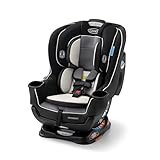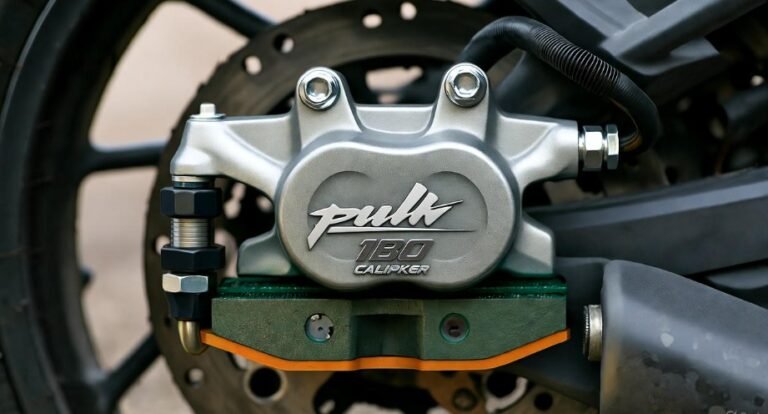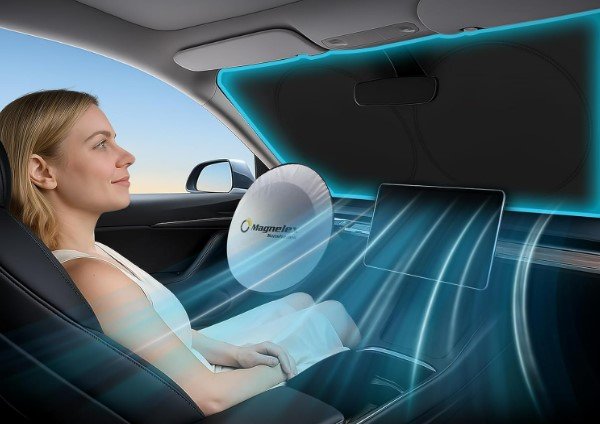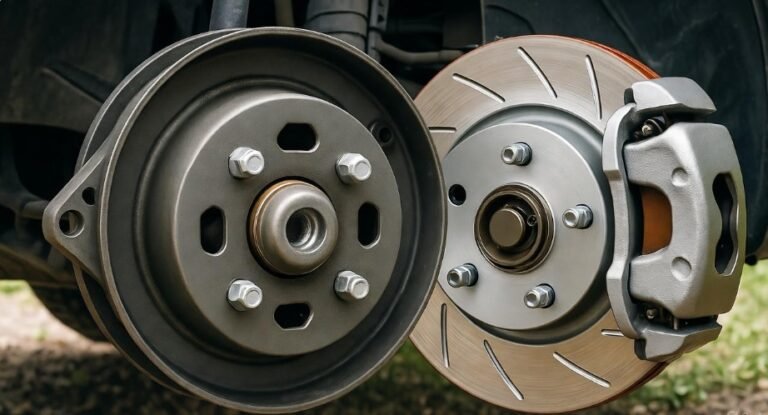Disc and Drum Brake Difference: What’s New?
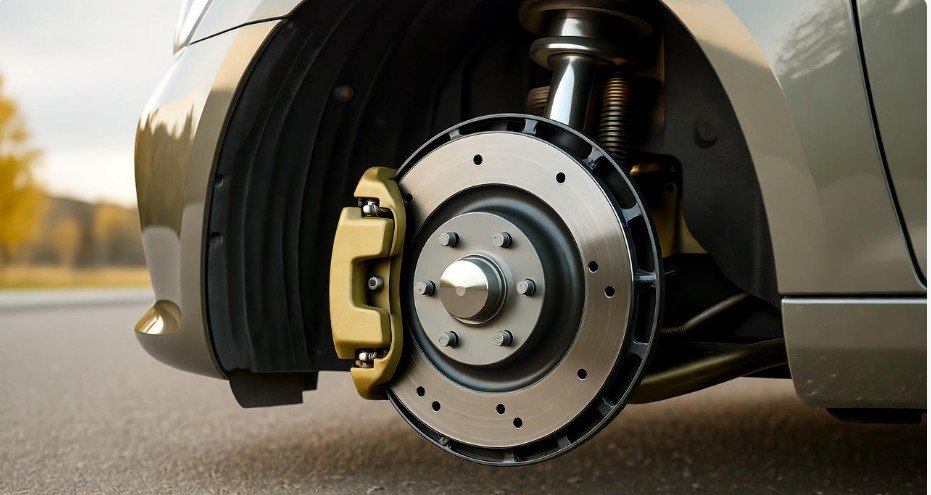
The disc and drum brake difference hinges on their design and application, with modern vehicles increasingly favoring disc brakes for superior stopping power and heat dissipation. Understanding this difference is key to appreciating advancements in automotive safety.
Key Takeaways
Identify disc versus drum brake systems.
Compare their stopping performance.
Explore heat management differences.
Learn about modern brake system innovations.
Understand maintenance and repair considerations.
Enhance your automotive knowledge for safer driving.
You might have heard mechanics or seen articles discussing “disc and drum brakes.” It can sound a bit technical, leaving you wondering what the big deal is. But understanding the basic disc and drum brake difference is actually quite important for your car’s safety and performance. Think of it as knowing the foundation of your car’s ability to stop quickly and reliably. We’ll break down what makes them tick, what’s changed, and why it matters for you, the driver. Get ready to demystify your car’s braking system.
Understanding Your Car’s Braking System: Disc vs. Drum Basics
At its core, your car’s braking system converts the kinetic energy of your moving vehicle into heat through friction, bringing you to a safe stop. The two main types of braking mechanisms you’ll find are disc brakes and drum brakes, each with its own unique design and operational principles. While they achieve the same goal, their methods and effectiveness can vary significantly, especially in today’s advanced automotive landscape.
How Disc Brakes Work: The Modern Standard
Disc brakes are what you’ll find on most modern cars, especially on the front wheels, and often on all four. They are known for their superior performance.
A disc brake system consists of a rotor (a flat metal disc attached to the wheel hub) and a caliper (a device that straddles the rotor). When you press the brake pedal, hydraulic fluid pushes pistons inside the caliper. These pistons then force brake pads to clamp down on both sides of the spinning rotor. This clamping action creates friction, which slows down and eventually stops the wheel.
The open design of disc brakes allows for excellent airflow, which helps to dissipate heat quickly. This is crucial because repeated braking, especially during descents or hard stops, generates a lot of heat. Overheating can lead to brake fade, where the brakes become less effective. Disc brakes are generally more efficient at managing this heat.
How Drum Brakes Work: The Traditional Approach
Drum brakes, once the standard on almost all vehicles, are now more commonly found on the rear wheels of some less performance-oriented cars or on older models. They also use friction to stop the wheel but operate differently.
A drum brake system features a brake drum, which is a hollow, cylindrical component that rotates with the wheel. Inside the drum are brake shoes, which are curved pieces lined with friction material. When you apply the brakes, hydraulic pressure pushes the brake shoes outward, pressing them against the inner surface of the rotating drum. This contact creates friction, slowing the wheel.
Drum brakes are enclosed, meaning the brake components are somewhat protected from the elements. However, this enclosure can trap heat and moisture, making them more susceptible to brake fade in demanding conditions and potentially leading to rust. They also tend to self-adjust to some extent, which can be a benefit in terms of automatic wear compensation.
Disc and Drum Brake Difference: A Comparative Look
To really grasp the disc and drum brake difference, let’s look at how they stack up against each other in key areas. This comparison highlights why disc brakes have become so prevalent in today’s automotive world, especially in the performance-driven American market.
Stopping Power and Performance
When it comes to raw stopping power, disc brakes generally outperform drum brakes. The ability of brake pads to clamp onto a rotor from both sides offers more consistent and powerful braking force. This is especially noticeable during emergency stops or when carrying heavy loads.
Drum brakes, while effective for normal driving, can sometimes feel less responsive, especially as they heat up. The outward push of the shoes can also lead to a slight “grabbing” or less linear application of force compared to the smooth, powerful bite of a disc brake.
Heat Dissipation and Fade Resistance
This is a significant area where disc brakes shine. Their open design allows air to circulate freely around the rotor, efficiently carrying away the heat generated by friction. This makes them much more resistant to brake fade, even under heavy use. You can feel more confident braking down long mountain roads or during spirited driving.
In contrast, the enclosed nature of drum brakes traps heat. As the temperature rises, the friction material can become less effective, and the metal components can expand, leading to a spongy brake pedal and significantly reduced stopping ability – a phenomenon known as brake fade. This is a major reason why manufacturers have moved towards discs, particularly on the front wheels where most of the braking effort is concentrated.
Maintenance and Durability
Both systems require maintenance, but the specifics differ. Disc brake pads tend to wear out faster than drum brake shoes because they are exposed and work harder. However, replacing disc brake pads is often a simpler and cleaner job for mechanics. Rotors can also wear down and may need resurfacing or replacement over time.
Drum brakes, being enclosed, can be a bit more complex to service. While shoes might last longer, inspecting them requires removing the drum, which can sometimes be seized or difficult to get off. The internal mechanisms can also accumulate dust and debris, potentially affecting performance over time.
Cost and Complexity
Historically, drum brakes were cheaper to manufacture, which is why they were used extensively. Disc brake systems, involving more precise engineering and components like calipers and rotors, were initially more expensive. However, as manufacturing processes have advanced and disc brakes have become standard, the cost difference has narrowed considerably.
For simpler, less demanding applications (like rear brakes on some economy cars), drum brakes can still offer a cost-effective solution. But for the performance and safety demanded by most modern drivers, the benefits of disc brakes often outweigh the slightly higher initial cost.
Key Differences in a Table
To make the disc and drum brake difference crystal clear, here’s a table summarizing their main characteristics:
| Feature | Disc Brakes | Drum Brakes |
|---|---|---|
| Design | Rotor spins, caliper squeezes pads onto rotor. | Drum spins, shoes push outward against drum’s inner surface. |
| Stopping Power | Generally higher and more consistent. | Good for normal use, can be less powerful under stress. |
| Heat Dissipation | Excellent due to open design and airflow. | Poor; heat gets trapped internally. |
| Brake Fade Resistance | High. | Lower, especially with heavy use. |
| Water/Debris Impact | More exposed, can be affected by water/dirt. | More protected by enclosure. |
| Maintenance Access | Generally easier to inspect and replace pads/rotors. | Can be more complex to access shoes and inner workings. |
| Common Application | Front wheels of most cars; often all four wheels. | Rear wheels of some cars; older vehicles. |
| Cost (Historically) | Higher. | Lower. |
What’s New? Innovations in Modern Braking Systems
The automotive industry is constantly pushing the boundaries of innovation, and braking systems are no exception. While the fundamental difference between disc and drum brakes remains, manufacturers are implementing new technologies to enhance performance, safety, and efficiency. These advancements are particularly relevant for drivers in the USA, where varied driving conditions—from city stop-and-go to long highway stretches—demand robust braking.
Advanced Disc Brake Designs
While disc brakes are standard, their execution continues to evolve.
Drilled and Slotted Rotors: These rotors have holes or slots machined into their surface. Drilled rotors help with heat dissipation and expel gases and water more effectively than solid rotors. Slotted rotors also help to clear the surface of pads and rotors, improving performance in wet or dirty conditions.
Multi-Piston Calipers: Standard calipers often have one or two pistons. High-performance vehicles and even many mainstream cars are now using calipers with four, six, or even more pistons. This allows for more even pressure distribution across the brake pads, leading to better stopping power and pad life.
Larger Rotors and Calipers: Simply put, bigger is often better. Larger rotors provide more surface area for braking and can better handle heat. Larger, stiffer calipers can apply more force more precisely.
Integration with Electronic Systems
The most significant advancements in braking aren’t just mechanical; they’re electronic. Modern cars integrate sophisticated electronic systems with the physical brakes.
Anti-lock Braking System (ABS): This is a standard safety feature in all new vehicles sold in the USA. ABS uses sensors to detect when a wheel is about to lock up (stop rotating) during heavy braking. It then rapidly pulses the brake pressure to that wheel, allowing the driver to maintain steering control while braking hard. The U.S. National Highway Traffic Safety Administration (NHTSA) mandates ABS for all light vehicles manufactured after September 1, 2011.
Electronic Brake-force Distribution (EBD): Often working in conjunction with ABS, EBD automatically adjusts the amount of brake force applied to each wheel based on vehicle load and road conditions. This ensures optimal braking balance, especially when the car is not loaded equally.
Brake Assist (BA): This system is designed to detect panic braking. If the driver slams on the brakes, Brake Assist recognizes the sudden force and automatically applies maximum braking pressure, even if the driver hasn’t pressed the pedal fully. This can significantly shorten stopping distances in emergencies.
Regenerative Braking (in Hybrids and EVs): Electric and hybrid vehicles use regenerative braking, a technology that’s transforming how cars slow down. Instead of just generating heat, the electric motor acts as a generator when the brakes are applied. It converts kinetic energy back into electrical energy, recharging the battery. This not only improves efficiency but also reduces wear on traditional friction brakes.
Improved Materials and Manufacturing
Manufacturers are also using advanced materials and manufacturing techniques:
Ceramic Composite Rotors: While typically found on very high-end performance cars, these rotors are lighter, resist extreme heat better, and produce less dust than traditional iron rotors.
High-Performance Brake Pads: New friction materials offer better performance across a wider temperature range, providing more consistent stopping power and longer life.
Advanced Surface Treatments: Rotors are often treated with coatings to prevent rust and improve initial break-in performance.
Pro Tips: Maintaining Your Brakes for Optimal Performance
Regular Inspections: Don’t wait for a problem! Have your brake pads, rotors, and fluid checked at every oil change or as recommended by your car’s manufacturer.
Listen to Your Brakes: Squealing, grinding, or groaning noises are warning signs. Address them immediately.
Check Brake Fluid: Brake fluid is crucial. If it’s low or dirty, it can compromise your braking system’s effectiveness. Consult your owner’s manual for the correct type and maintenance schedule.
Feel the Pedal: A spongy or soft brake pedal, or a pedal that sinks to the floor, indicates a serious issue that needs immediate attention.
Disc and Drum Brake Difference: When to Consider Upgrades
While modern vehicles come equipped with effective braking systems, there are times when an upgrade might be beneficial, especially if you drive a performance vehicle or frequently encounter demanding driving conditions.
Upgrading Disc Brakes
If your car already has disc brakes, you can enhance their performance.
Performance Brake Pads: Replacing standard pads with high-performance ones can offer better bite, higher heat tolerance, and improved fade resistance. This is a relatively simple and cost-effective upgrade for spirited drivers.
Drilled or Slotted Rotors: These can improve cooling and performance, especially in wet conditions or during hard braking.
Stainless Steel Brake Lines: Replacing rubber brake lines with braided stainless steel lines can provide a firmer, more responsive pedal feel because they don’t expand under pressure like rubber lines can.
Big Brake Kits: For the ultimate upgrade, “big brake kits” replace your entire front (and sometimes rear) brake setup with larger rotors, multi-piston calipers, and specialized hardware. These offer significant improvements in stopping power and heat management but come at a higher cost.
Upgrading Drum Brakes (or Converting)
Upgrading drum brakes directly is less common and often less impactful than upgrading disc brakes. In many cases, it’s more practical to convert rear drum brakes to disc brakes.
Rear Disc Conversion Kits: These kits replace the rear drum setup with a disc brake system. This offers the benefits of improved stopping power, better heat dissipation, and a more consistent feel, especially if the front brakes are already discs. These conversions can be complex and expensive, often requiring custom fabrication or specialized components.
Performance Drum Components: For those who wish to keep their drum brakes, some aftermarket parts might exist, such as higher-performance brake shoes or improved drum materials, but these are generally less common than disc brake upgrades.
Who Benefits Most from Upgrades?
Performance Car Enthusiasts: Drivers who take their vehicles to the track or autocross events will see the most significant benefits from upgraded brakes.
Towing and Hauling: If you frequently tow a trailer or carry heavy loads, upgraded brakes can provide greater safety and control.
Mountainous Regions: Drivers in areas with frequent steep grades will benefit from enhanced heat management and fade resistance.
Drivers Seeking Enhanced Safety: Even for everyday driving, a well-executed brake upgrade can provide greater peace of mind and improved safety margins.
Frequently Asked Questions About Disc and Drum Brakes
1. Which brake type is safer, discs or drums?
Disc brakes are generally considered safer due to their superior stopping power, better heat dissipation, and resistance to fade. This makes them more reliable in emergency situations and demanding driving conditions.
2. Why do some cars still have drum brakes?
Drum brakes are often used on the rear wheels of less expensive or older vehicles because they are cheaper to manufacture and can provide adequate braking for lighter loads and less demanding use. They can also offer some self-adjusting capabilities.
3. How often should I replace my brake pads and rotors?
This varies greatly depending on driving habits, vehicle type, and the quality of the parts. Typically, brake pads might last 25,000-70,000 miles, and rotors can last 50,000-100,000 miles or more, often being resurfaced before replacement. Always consult your owner’s manual and have them inspected regularly.
4. Can I mix disc and drum brakes on my car?
Yes, it’s very common for cars to have disc brakes on the front and drum brakes on the rear. This setup balances performance needs with cost-effectiveness, as most braking force is applied by the front wheels. Some performance upgrades involve converting rear drums to discs.
5. What does “brake fade” mean?
Brake fade is the temporary loss of braking ability that occurs when brake components (especially rotors and pads) overheat. The extreme heat can reduce the friction coefficient between the pad and rotor, making the brakes less effective and leading to a spongy pedal feel. Disc brakes are significantly more resistant to fade.
6. Are hybrid and electric car brakes different?
Yes, hybrid and electric vehicles often use regenerative braking in addition to traditional friction brakes (which are usually disc brakes). Regenerative braking uses the electric motor to slow the car and recharge the battery, reducing wear on the friction brakes.
7. Where can I find information on my specific car’s brake system?
Your car’s owner’s manual is the best place to start. It will detail the type of brakes your vehicle has and its recommended maintenance schedule. You can also consult a qualified mechanic or reputable automotive resources online.
Conclusion
Understanding the disc and drum brake difference is a fundamental aspect of appreciating your vehicle’s engineering and ensuring your safety on the road. While drum brakes served their purpose for decades, the evolution of automotive technology, driven by demands for greater safety and performance, has firmly established disc brakes as the superior choice for most modern applications.
The advancements we’re seeing today, from sophisticated electronic systems like ABS and EBD to innovative materials and designs for disc components, are all aimed at making your driving experience safer and more responsive. Whether you’re a seasoned driver navigating the highways of the USA or a new resident getting familiar with American driving, knowing how your brakes work empowers you to make informed decisions about maintenance and potential upgrades. Keep those brakes in top condition, and you’ll drive with confidence, knowing you have reliable stopping power at your command.

